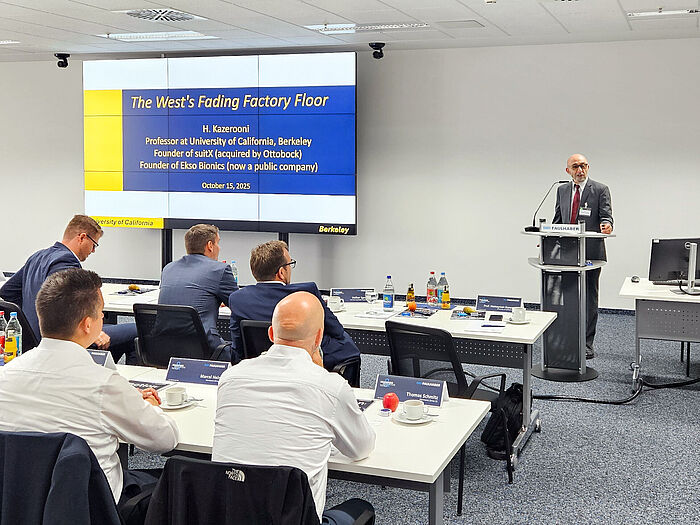With his keynote “Intelligent Manipulation – Fine Motor Skills for Humanoid Robots,” Prof. Homayoon Kazerooni demonstrated just how close this future already is. The renowned researcher from the University of California, Berkeley, offered exciting insights into the current state of humanoid robotics – and into a technology with the potential to fundamentally transform the working world.
“Humanoids are here for real.” With this statement, Prof. Kazerooni emphasized that the potential of humanoid robots extends far beyond research laboratories: in manufacturing, assembly, maintenance, logistics, and warehousing, they open up entirely new possibilities for industrial automation.
The Trio of Human Competence
Using the example of production workers, Prof. Kazerooni illustrated the three central elements of human labor: intelligence, vision, and manipulation.
- “Ordinary intelligence” – thinking – is implemented in humanoid robots through artificial intelligence.
- Vision is handled by cameras and image-processing systems.
- Manipulation – grasping and movement – is enabled by advanced robotic hands and grippers.
This makes it clear that modern humanoids are already approaching the essential human abilities: cognitive intelligence, perception, and fine motor dexterity.
Humans remain at the center
A central statement of his talk was: “We are not replaced by AI – we are replaced by people who know how to use AI.” Prof. Kazerooni thus made it clear that it is not artificial intelligence itself that replaces jobs, but the people who know how to use it effectively. The future of work lies in the ability to handle technology intelligently and competently.
Algorithms alone are useless without suitable hardware to run them. According to Kazerooni, the robotic hand remains one of the greatest bottlenecks on the path to fully autonomous systems. Yet it also holds much of the future: lightweight, robust, and sensitive tools that combine physical competence with intelligent control and can quickly learn new tasks.
He called for a new mindset: “Build different. Build with humanoids.” Only through the use of humanoid systems, he argued, can full automation of production and assembly become reality. The next generation of robotic hands must feature advanced physical properties, autonomous learning, intuitive human-machine interaction, and powerful motors – such as those developed by FAULHABER.
Technological boundaries – and opportunities
“The barrier is not imagination, but technology.” This statement summarizes the essence of his message: the limits of progress lie not in imagination but in available technology. Yet it is precisely there that innovation arises – through lighter, more sensitive, and smarter systems that perfect the interplay between physical and digital intelligence.
The field of humanoid robotics is vast and full of opportunity. Prof. Kazerooni urged everyone to actively engage with this development: to reflect on why and how we want to use humanoid systems – and how we can shape their progress to our advantage. In his closing words, he emphasized: “I believe in healthy competition.” The advancement of robotics, he said, is driven by competition, collaboration, and the shared pursuit of excellence.
About Prof. Homayoon Kazerooni
Prof. Homayoon Kazerooni is a professor of mechanical engineering at the University of California, Berkeley, and one of the world’s leading experts in robotics, exoskeletons, and human-machine systems. With over 30 years of research experience, he has significantly shaped the development of modern assistive and robotic systems that intelligently connect humans and machines. As the founder of suitX (by Ottobock) and Ekso Bionics, Prof. Kazerooni has played a key role in transferring exoskeleton technology from research into practical use – in medicine, industry, and rehabilitation.
